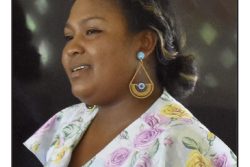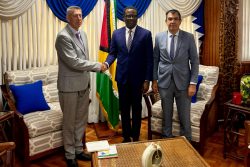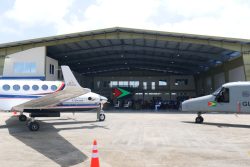 Two-year-old Zainab Mughal seems like any toddler with her huge smile and love of toys. But the South Florida girl with the chubby cheeks and big, bright eyes has lost her curls and is now bald, as she bravely battles an aggressive childhood cancer. This month, her parents launched a desperate international appeal and search for blood donors with a rare genetic variation.
Two-year-old Zainab Mughal seems like any toddler with her huge smile and love of toys. But the South Florida girl with the chubby cheeks and big, bright eyes has lost her curls and is now bald, as she bravely battles an aggressive childhood cancer. This month, her parents launched a desperate international appeal and search for blood donors with a rare genetic variation.
The American not-for-profit community organisation, OneBlood.org is leading the online drive to locate the only people who are likely to be a match for Zainab (www.oneblood.org/zainab/). Statistically, these are donors of blood type “O” or “A” and exclusively of Pakistani, Indian or Iranian descent. Few are like Zainab, missing a common antigen that most people carry on their red blood cells, called “Indian B” (Inb), so named because an estimated 4% of Indians possess it.
Antigens are either sugars in the case of the ABO blood group, or proteins in the other major blood band termed “Rh,” that prompt the production of antibodies in the human body. The surviving term “Rh” was originally a misnomer abbreviation of “Rhesus factor” erroneously believed to be similar to the surface marker found in rhesus monkey red blood cells.
Before the 1900s, it was thought that all blood was indeed one blood, and the same, leading to fatal consequences be it for monkeys, dogs, cows or guinea pigs whether human or the cuddly South American cavy, that is neither a pig nor from Guinea, instead originating in the Andes. It would take the Austrian physician and biologist Karl Landsteiner’s curious clumping experiments with his own blood and samples drawn from just 12 hardy members of his laboratory to sort out the confusion, and to discover the three main blood groups A, B and C, the last later renamed O, were all inherited.
In 1902, the less frequent AB variant was identified. Based on Landsteiner’s findings which eventually won him the Nobel Prize in Physiology or Medicine in 1930, the first successful blood transfusion was performed at New York’s Mount Sinai Hospital in 1907. Described as the father of transfusion medicine, Landsteiner’s efforts single handedly pioneered early paternity tests! By the middle of the 20th century, the American researcher Philip Levine confirmed a new way to classify blood, based on whether it had the Rhesus (Rh) blood factor.
The ABO and the Rh categories determine someone’s blood type whether A, B, AB and O, with positive, negative or null, denoting the Rh status. So far, only three matches have been found for Zainab, two in the United States of America and another near London in the United Kingdom. About seven other donors are needed to provide transfusions over the long-term for the young patient as she continues treatment for neuroblastoma, a cancer of the nerve cells, diagnosed as a tummy tumour in October.
Due to Landsteiner’s invaluable work, we know that persons with the least occurring of the major blood groups, AB, are universal recipients and can accept the red liquid of life from others, while individuals with blood group O-negative can give to all as universal donors. Now, the International Society of Blood Transfusion (ISBT) recognises at least 36 “blood groups systems” in which 308 antigens are clustered. Another remaining 38 antigens remain unassigned.
Landsteiner named the M/N and P blood systems, with steady additions through the years of rare blood groups like Lutheran (Lu), Lewis (Le), Kell (K), Duffy (FY), Kidd (Jk), Race (RR), Diago (Di), Auberger (AU) and Dombrock (Do). In 2012, researchers announced that they had identified proteins for the rare Langereis and Junior blood types, common among smaller ethnic populations, with about 50,000 Japanese believed to carry the Junior negative blood type.
Earlier in the 1990s, scientists had pinpointed the single gene ABO on chromosome 9 as being behind the blood types, but the evolutionary reason for the mysterious variations over several million years remains elusive. Among the hypotheses is the suggestion that the three major races of man, blood groups A in Europe, B in Asian, and then O in South America emerged due to migration and mixing. Yet, isolated populations can have completely different blood groups.
According to another, the emergence of all blood groups A and B and their subgroups resulted from successive mutations, from a basic and common O blood group. It proposes the old races mostly have this type such as the indigenous Indians of South America, and the native Inuit of North America, while in most recent ethnic groups the A and B groups are dominant.
A third propounds that the first blood group was AB, and due to genetic mutations and natural selection, it resulted in A and B and finally the most common, O blood group which better resists numerous infectious diseases.
Molecular experts agree that the ABO scheme is ancient, since humans and all other primates share this trait, inheriting these blood types from a common ancestor at least 20 million years ago. Comparisons at the National Centre for Scientific Research in Paris have ascertained that gibbons and humans both have variants for A and B blood types. Some lineages have lost one, with our closest living relatives, the chimpanzees showing types A and O blood, even as gorillas display only B.
Given the OneBlood appeal and the wisdom of proverbs like, “you cannot get blood from a stone” and “blood is all of a colour,” this holiday season, we can choose to donate to the National Blood Transfusion Services (NBTS) wherever we are, against the ongoing demand for all blood groups, in times of sickness and in health. Thinking back to when I summoned up courage to present my first pint as a thin teenager, during which I learnt to my surprise that I had a rare blood type, I remembered my mind’s meanderings and musings, while lying on the stretcher, on the special Guyanese and West Indian forms of lovesickness be it the romantic “typee” or the severe form “tabanca.”
Expounding on the terms, the famed Guyanese folklorist, poet and broadcaster, Wordsworth McAndrew would list an incredible 40 such descriptions of sister synonyms including from Trinidad, St. Vincent, St. Lucia and Grenada in his classic 1979 unmatched manual, “Oooiy!” named after the popular Creolese salutation.
Humour, then as now, was definitely in the blood, so stage 14 of “typee” in the word master’s list
typhosious rikkitlks” deliberately sounds like a deadly disease. Others range from “chiranghi” to the floral sounding “frangilangi pang,” “soojee–moojee,” “gooroop” and of course, the tremendous “toteelotteepo.”
Across in Central America, the Belizeans have long realised that, “Blood can’t wash out with blood” (Two wrongs don’t make a right). While family may come first as in “Blood falla (follows) vein” as usually evident by the region’s politicians, it is true too that “Blood may be ticka dan (thicker than) water, but water taste better.” As the Mughal family is indeed finding out we may one day have to depend on the kindness and blood of strangers to save a life.
ID’s spouse reminds her that Trinis like to declare, “My blood take” when they are attracted to someone. She found out that they share the same rare blood type with their children, who had no choice in the matter but did not take kindly to the risks and genetic predispositions.







